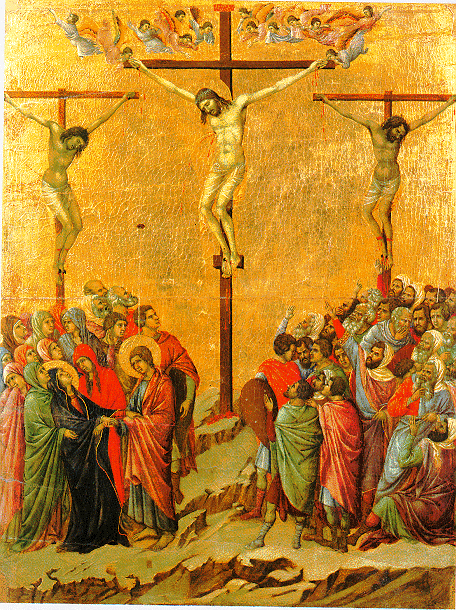


Crucifixion Duccio di Buoninsegna. Siena, Museo dell'Opera del Duomo |
CRUCIFIXION, execution of a criminal by nailing or binding to a cross.
It was a common form of capital punishment from the 6th century BC
to the 4th century AD, especially among the Persians, Egyptians,
Carthaginians, and Romans. The Romans used crucifixion for slaves and criminals
but never for their own citizens. Roman law provided that the criminal
be scourged before being put to death; the accused also had
to carry either the entire cross or, more commonly, the crossbeam from the place of scourging to the place of execution. The practice was abolished in 337 by Constantine I out of respect for Jesus Christ, who died on the cross. The crucifixion of Christ between two thieves is recorded in the New Testament by all four evangelists (see Matt. 27:33-44; Mark 15:22-32; Luke 23:33-43; John 19:17-30). The significance of the crucifixion has been a subject for theological discussion throughout church history. (from http://www.fwkc.com/encyclopedia/low/articles/c/c005002364f.html)
|
| Introduction to Resurrection |
|
| Discussion of Resurrection |
|
| Study
Questions
generously provided by Sister Heliena Krenn |
| Lk 22.1-24.1-12, 24.50-53; Jh 19.38-20.1-18: PASSION DRAMA AND THE
RESURRECTION & ASCENSION: Jesus knew the prophecies of the OT about
the Messiah's death and resurrection. Repeatedly He had spoken to His apostles
about these impending events.
1. Lk 22.1; The timing of Jesus's death: Review the OT event of the
Passover (Ex 12.21-32); can you see a symbolic connection between the Passover
celebration of the Jews and the death of Jesus?
TERMS TO REMEMBER: cross, passion, crucifixion, Last Supper, Mass,
New Covenant, Mount of Olives, Judas, Messiah, Pilate, Resurrection
|
 |
 |